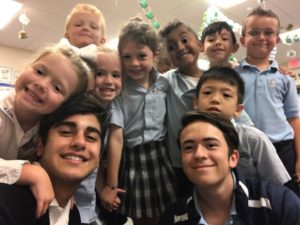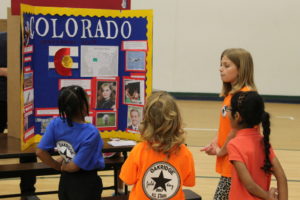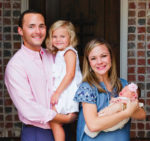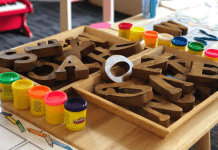Disclaimer :: The Oakridge School sponsored this blog post and tackles the topic of kids missing out on the art of conversation and public speaking.
We have all been there — sweaty palms, chattering teeth, and shaky knees upon being asked to speak in public, whether it be to an audience of one or 100. In countless surveys, when asked to name their biggest fear, the majority of respondents list public speaking, even over death. It’s quite puzzling to think that something that so many of us take for granted, the art of conversation, has become overwhelming.
All too often you walk across a high school or college campus and see the same thing: students walking alone, headphones draped around their necks, and their eyes glued to their phones. We’ve lost the art of casual conversation.
 Like many students, I too am guilty of being driven by technology. As a young mom to an almost two-month-old baby and a three-year-old child, I have found that I must make a point to put the phone away and truly engage with my kids. It seems crazy to admit, but without paying attention to where we are focusing our time, we are losing the soft skills — small talk and even basic face-to-face conversation.
Like many students, I too am guilty of being driven by technology. As a young mom to an almost two-month-old baby and a three-year-old child, I have found that I must make a point to put the phone away and truly engage with my kids. It seems crazy to admit, but without paying attention to where we are focusing our time, we are losing the soft skills — small talk and even basic face-to-face conversation.
When I am not busy being a mom and a wife, I serve as a Learn 21 specialist and fourth grade teacher at The Oakridge School. In essence, I focus on technology integration while also helping students become the best versions of themselves. How did I get here? Family.
A Real Family
Family is a word you will often hear others use to describe The Oakridge School. As an alpha and omega alumna (I started as an Oakridge student at the age of four), I can confidently say that Oakridge took me in as part of its family and taught me how to communicate. I felt so inspired by the connection that the faculty create with the students at Oakridge that, upon graduation from TCU, I joined the faculty. This is my first year as an Oakridge parent, my ninth year as an educator, and my 24th year as a member of the Oakridge family.
 At Oakridge, we believe in the importance of communication and public speaking. A few years ago, I led a small group of educators in a two-year dialogue about how to structure a public speaking curriculum. We created a blueprint of what an Oakridge student’s journey in public speaking would look like from our youngest learners in the Early Childhood Center all the way to our graduating seniors.
At Oakridge, we believe in the importance of communication and public speaking. A few years ago, I led a small group of educators in a two-year dialogue about how to structure a public speaking curriculum. We created a blueprint of what an Oakridge student’s journey in public speaking would look like from our youngest learners in the Early Childhood Center all the way to our graduating seniors.
You Talk; We’ll Listen
If you stumble into one of our preschool rooms on any given day, you will find students sitting on the carpet speaking in front of their peers and practicing the art of conversation. In fact, recently I was scrolling through Instagram and came upon my three-year-old daughter’s class account and found videos of the students standing in front of their peers, speaking Spanish into a pretend microphone, and introducing themselves. At three years old! If our youngest learners are already doing this, imagine the possibilities when they become seniors on our campus.
 In the Lower School, we look forward to “Diffendoofer Day,” a title we borrowed from Dr. Seuss about a school that teaches its students to think differently. Our students spend months creating a passion-based presentation of their choice. They research their chosen topic and deliver a three-to-five minute presentation in front of their classmates. From origami to cheerleading, and dogs to countries, the topics chosen lead up to student presentations where skills are honed. Speeches include a strong opening, good eye contact, and a focus on inspiring an audience.
In the Lower School, we look forward to “Diffendoofer Day,” a title we borrowed from Dr. Seuss about a school that teaches its students to think differently. Our students spend months creating a passion-based presentation of their choice. They research their chosen topic and deliver a three-to-five minute presentation in front of their classmates. From origami to cheerleading, and dogs to countries, the topics chosen lead up to student presentations where skills are honed. Speeches include a strong opening, good eye contact, and a focus on inspiring an audience.
The emphasis on public speaking and communication grows when students reach middle school. They are given more opportunities to speak in class, deliver presentations, and spend a semester in Capstone, a class culminating in a performance hall presentation in front of peers, teachers, and parents. We have had students speak about everything from the importance of saving money to the power of perseverance.
Now, this takes us to senior year in which students, once again, are on the big stage in the school performance hall as part of the “Owls Speak Out” program. Students present passion projects in the form of a short speech in front of faculty, family, and the entire Upper School student body.
Students at Oakridge are brought up to be confident public speakers. Whether it’s the youngest among us, or those closest to graduation, each student is taught valuable skills in public speaking, communication, and being a good listener in each classroom on their academic journey. Every faculty member makes it a priority to incorporate public speaking and skill building into the curriculum, and the opportunities to practice those skills are plentiful. The Oakridge classroom is a safe place for students to learn core academic subjects while also focusing on character development and relational skills.
By creating a comfortable, family-like environment, we build our students’ confidence, inspire them to seek their full potential, and create an atmosphere to help our students find their voices. We feel certain that this helps distinguish and set them apart in college and even into the workforce for years to come. It’s why I continue to learn (and teach) at Oakridge, and why my children will do the same.
 Ashley Brentlinger Read works as a fourth grade teacher and technology integrationist at The Oakridge School in Arlington, Texas. She and her husband David have two young children and reside in the DFW area. You can follow The Oakridge School on Facebook, Instagram, Twitter, and YouTube.
Ashley Brentlinger Read works as a fourth grade teacher and technology integrationist at The Oakridge School in Arlington, Texas. She and her husband David have two young children and reside in the DFW area. You can follow The Oakridge School on Facebook, Instagram, Twitter, and YouTube.













